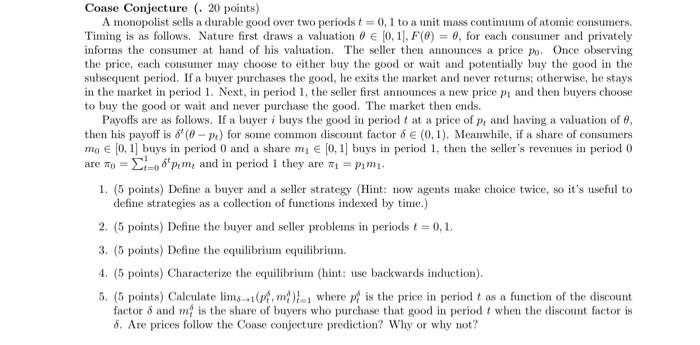Answered step by step
Verified Expert Solution
Question
1 Approved Answer
Please help Coase Conjecture (- 20 points) A monopolist sells a durable good over two periods t = 0,1 to a unit mass continuum of
Please help 
Coase Conjecture (- 20 points) A monopolist sells a durable good over two periods t = 0,1 to a unit mass continuum of atomic consumers. Timing is as follows. Nature first draws a valuation 0 (0.1), F(0) = 0, for each consumer and privately informs the consumer at hand of his valuation. The seller then annonces a price po. Once observing the price, each consumer may choose to either buy the good or wait and potentially buy the good in the subsequent period. If a buyer purchases the good, he exits the market and never returns; otherwise, he stays in the market in period 1. Next, in period 1, the seller first announces a new price pi and then buyers choose to buy the good or wait and never purchase the good. The market then ends. Payoffs are as follows. If a buyer i buys the good in period t at a price of p, and having a valuation of , then his payoff is 8(0-P) for some common discount factor 8 (0.1). Meanwhile, if a share of consumers mo (0.1) buys in period 0 and a share my (0.1] buys in period 1, then the seller's revenues in periodo are To = = d'peme and in period 1 they are 1 = pm. 1. (5 points) Define a buyer and a seller strategy (Hint: now agents make choice twice, so it's useful to define strategies as a collection of functions indexed by time.) 2. (5 points) Define the buyer and seller problems in periods t = 0,1. 3. (5 points) Define the equilibrium equilibrium. 4. (5 points) Characterize the equilibriun (hint: use backwards induction) 5. (5 points) Calculate lims- 1m where is the price in period t as a function of the discount factor & and mis the share of buyers who purchase that good in period t when the discount factor is 8. Are prices follow the Conse conjecture prediction? Why or why not? Coase Conjecture (- 20 points) A monopolist sells a durable good over two periods t = 0,1 to a unit mass continuum of atomic consumers. Timing is as follows. Nature first draws a valuation 0 (0.1), F(0) = 0, for each consumer and privately informs the consumer at hand of his valuation. The seller then annonces a price po. Once observing the price, each consumer may choose to either buy the good or wait and potentially buy the good in the subsequent period. If a buyer purchases the good, he exits the market and never returns; otherwise, he stays in the market in period 1. Next, in period 1, the seller first announces a new price pi and then buyers choose to buy the good or wait and never purchase the good. The market then ends. Payoffs are as follows. If a buyer i buys the good in period t at a price of p, and having a valuation of , then his payoff is 8(0-P) for some common discount factor 8 (0.1). Meanwhile, if a share of consumers mo (0.1) buys in period 0 and a share my (0.1] buys in period 1, then the seller's revenues in periodo are To = = d'peme and in period 1 they are 1 = pm. 1. (5 points) Define a buyer and a seller strategy (Hint: now agents make choice twice, so it's useful to define strategies as a collection of functions indexed by time.) 2. (5 points) Define the buyer and seller problems in periods t = 0,1. 3. (5 points) Define the equilibrium equilibrium. 4. (5 points) Characterize the equilibriun (hint: use backwards induction) 5. (5 points) Calculate lims- 1m where is the price in period t as a function of the discount factor & and mis the share of buyers who purchase that good in period t when the discount factor is 8. Are prices follow the Conse conjecture prediction? Why or why not 
Step by Step Solution
There are 3 Steps involved in it
Step: 1

Get Instant Access to Expert-Tailored Solutions
See step-by-step solutions with expert insights and AI powered tools for academic success
Step: 2

Step: 3

Ace Your Homework with AI
Get the answers you need in no time with our AI-driven, step-by-step assistance
Get Started


